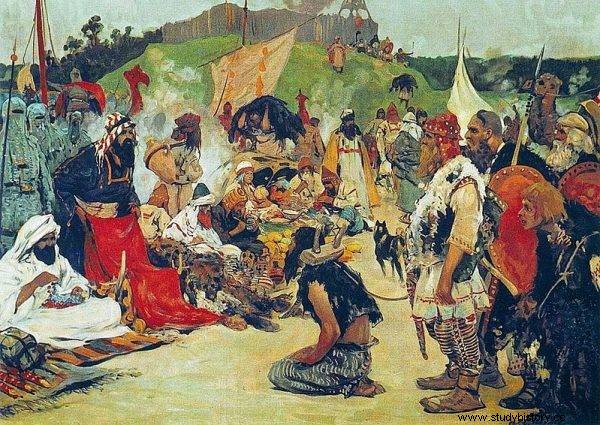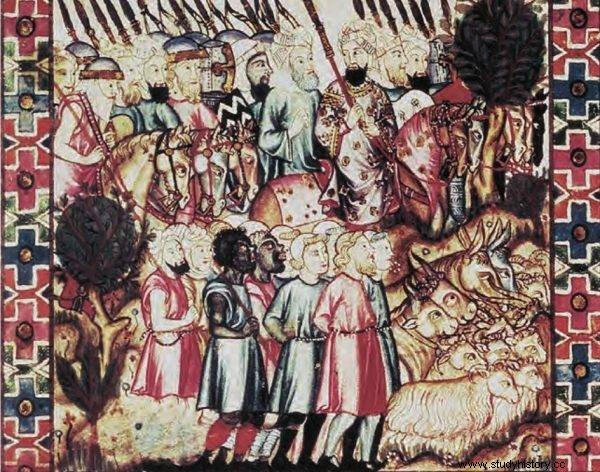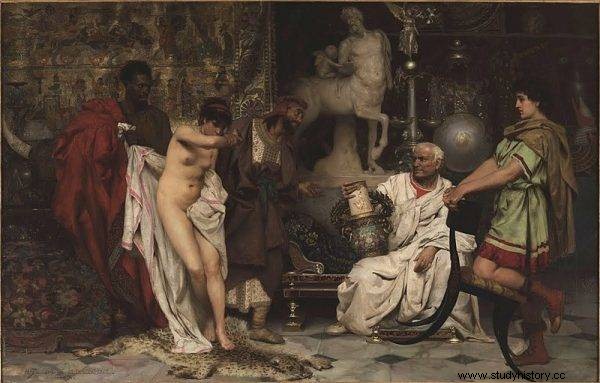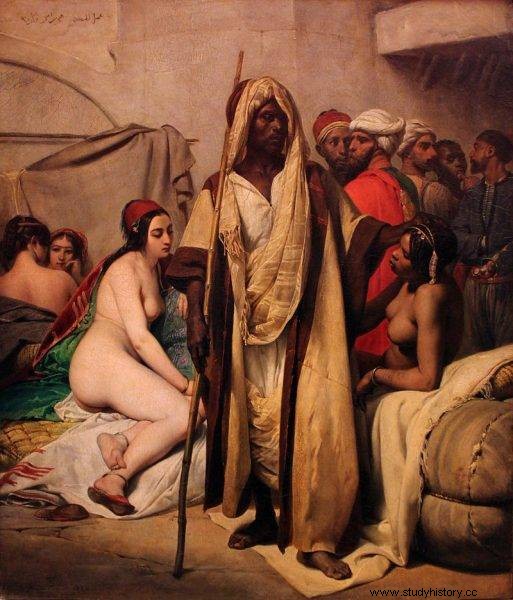Beautiful Slavic women and strong Slavic men were the most "salable" goods of the early Middle Ages. For them, it was profitable to travel thousands of kilometers. Jewish and Arab merchants from the Middle East, Iberian Peninsula and Byzantium came to our part of the world to buy the slaves.
Saqaliba - is the collective name of Slavic slaves, used by merchants from the Arab world. Expeditions from the south to the far north headed for famous castles and commercial settlements. A large slave market operated, among others in Prague, trade also took place in the so-called port of trade, i.e. Baltic emporia, such as the Slavic Wolin (Jomsborg / Wineta), the Prussian Truso or the Scandinavian Hedeby.
The newcomers from the south paid a lot for their slaves - silver coins at that. Not only did they earn money from the slave business who carried living goods to the markets in the Middle East or to the courts of rulers, but also the relatives of those who were slaves. For often it was the Slavs of the Slavs who prepared a slave fate .

The newcomers from the south paid a lot for the slaves - and silver coins at that.
The exploitation and trade of slaves was carried out by warlords from tribal groups, as well as by pirates - not only the Scandinavian Vikings. The sea bandit was also successfully practiced by Slavic pirates - the so-called more.
And the first Piast rulers made profits from slavery. Admittedly, the adoption of Christianity curtailed the human trade, but still the bandits were an important flywheel of the Piast economy . Even in the 12th century, Gallus Anonymous mentioned the invasion of Bolesław the Wrymouth on the pagan Prusai:"he accumulated immense spoils, capturing men and women, boys and girls, slaves and slaves innumerable, burning buildings and numerous villages".
The captives were used as labor. They inhabited the areas of cleared forests. There, the so-called servant villages that specialized in specific services for the court - e.g. pigs, dogs, blacksmiths.
Slavic locust
Western Slavic slaves - most often via Venice - ended up in Arab Andalusia and North Africa. In turn, slaves from the Eastern Slavic region, sold in Kiev, were usually led to the Byzantine Empire and the Arabian Peninsula.
Markets, like those in Cordoba or Baghdad, were full of white people with blue eyes and blonde hair.

Markets, like those in Cordoba or Baghdad, were full of white people with blue eyes and blonde hair.
"Slavic locusts are literally blocking the streets of Baghdad" - wrote the Arab poet Abu Yaqub Ali ibn Gabala at the beginning of the 9th century. There were so many slaves from Central and Eastern Europe that local diasporas were formed. In Sicily - in the Arabic then Palermo - there was a district of the Slavs, and in Syria some names derived from the Slavic language have survived.
Slav, or slave?
So did the name of the ethnic group, which Poles also belong to, come from the Latin word sclavus , that is, a slave ? This strong thesis was once strongly emphasized by Nazi researchers, incl. in order to emphasize the superiority of Germany over the Slavic peoples. However, it is not confirmed by modern science.
According to some researchers, the name Slavs comes from "word". So the Slavs would be those who knew the "words", that is, the common Slavic speech. Others see its origin as slava , a popular Slavic greeting (fame / glory), also appearing as part of Slavic names.

In ancient Rome, a man of a prisoner was called servus and not sclavus
However, there are also those who see the Latin link sclavus (slave) with the Slavs. Admittedly, classical Latin did not know such a concept, and in ancient Rome a man of a slave state was called servus not sclavus However, it was in the early Middle Ages that, due to the large number of Slavic captives, the term Slavs could become an eponym for the term "slave" - regardless of the origin. This only confirms how saturated with slaves from our part of the world the human trafficking market was in the early Middle Ages.
Careers without gems
Was a terrible fate awaiting when sold into slavery to Arabia? Well, he could have been castrated. This is one of the gloomier scenarios that is unfortunately often practiced among Arab slave owners. Young boys were usually castrated, but not only - also men especially when they were not of value as, say, soldiers.
What's more - the owners were even suggested castration. Arab scholar Al-Jahiz (776-869) from the Baghdad Caliphate, wrote that "the first thing castrated by a Slav is to increase his intelligence" . In turn, according to him, an uncastrated Slavic slave "will remain with his inborn ignorance and stupidity inherent in the Slavs."
What happened next with the Slavic slave? One could say that he had a pretty good life ahead of him, as long as he avoided the loss of "jewels" or did not miss them ... The records of Arab chroniclers are full of accounts of Slavs who started in captivity, but reached significant positions at the courts of caliphs.

Was a terrible fate when sold into slavery to Arabia?
Slavic men proved themselves in the ranks of the army to such an extent that the caliphs organized special bodyguards made up of Slavs. This is what the founder of the city of Cairo - Caliph Al-Mu'izz. According to the chronicles, in order to better understand his Slavic military - he learned their language.
At that time, Arab Cordoba was mainly sent to slaves from the Western Slavic region, from the area of today's eastern Germany and Poland. The Caliph of Cordoba Abd ar-Rahman III (912–961) had a Slavic personal guard of as much as 13,000. soldiers! Wojowie dealt with, inter alia, pacifying the riots of the Berber tribes. The Caliph deliberately chose the Slavs - not only because of their bravery, but also because they were from outside. They guarded the throne against the attempts of possible rivals from the local aristocracy. Most of the high positions in the army and administration of the caliphate were occupied by the Slavs.
The ruler had one more reason to favor the visitors from the north. A certain Murchana - this name hides the caliph's lover, who was to come from the Slavic region. She bore him a son and later ruler of Al-Hakam II. It was he who sent his spy and trader, Ibrahim Ibn Jakub, to the Vistula River, who gave us the first report about Mieszko's country.
Saqalib's rebellion
Of course, life in shackles has not always been dotted with roses. In the Arab kingdom of Nekor in today's Morocco, at the turn of the 11th and 10th centuries - under the emir of Said ibn Saleh - the the rebellion of Saqalib, or the rebellion of the Slavs.
The echoes of those events found their way into the pages of the so-called "Books of Roads and Kingdoms", an 11th-century chronicle, which is a kind of guide written for Arab merchants. As reported by Al-Bakir - the author of the chronicle - the revolt in Nekor was initiated by the emir's Slavic warriors, who formed his personal guard . They demanded privileges and freedom from him. When they were refused, they terrorized the manor, then fled from Nekor to the Rif Mountains. There, they established their own settlement and introduced their own cleanups - the same as they knew from their native country, covered with dense forest.
What happened next? Probably, the emir finally managed to suppress the rebellion, and the rebels were punished with death, as did their allies from the palace opposition, who tried to throw the hated ruler from the throne by the hands of Slavic warriors. Was it so, or maybe the Slavic village existed for many years? Only the excavations can answer this question.
In 2016, Polish archaeologists undertook the search for a Slavic village in Morocco. No effect so far, but let's hope that soon the material remains of Qarjat as-Saqaliba - a Slavic stronghold in Morocco - will see the light of day.
Bibliography:
- Beata Abdallah, Slavs in the eyes of medieval Arab writers [in:] Multiculturalism:postulate and practice , edited by:Leszek Drong, Wojciech Kalaga, Katowice:Publishing House of the University of Silesia 2005.
- Jakub Belzyt, Selected Hebrew sources about the peoples of Central and Eastern Europe in the 10th-13th centuries, "Scripta Historica", 22/2017.
- Zofia Kowalska, The slave trade run by Jews in the 9th-11th centuries in Europe [in:] Slavery and slaves in Europe from antiquity to modern times, edited by:Danuta Quirini-Popławska, Krakow:Jagiellonian University Publishing House 1998.
- Urszula Lewicka-Rajewska, Arab description of the Slavs:sources to the history of medieval culture, Krakow:Polish Folklore Society 2004.
- Tadeusz Lewicki, Slavic settlement and Slavic slaves in Muslim countries according to medieval Arab writers, "Przegląd Historyczny" 43/1952.
- Jerzy Nalepa, North-Western Slavic. Fundamentals of unity and its disintegration , Poznań Society of Friends of Sciences, Poznań 1968.
- Andrzej Poppe, Slave Trade in Rus . "Dictionary of Slavic antiquities" 2/1, 1964. Ossolineum.
- Ignacy Schiper, The history of Jewish trade in Poland, Warsaw - Krakow:Headquarters of the Merchants' Union 1937.
- Kacper Śledziński, Wojowie i grody. The Slavic Barbaricum , Libron 2008.
